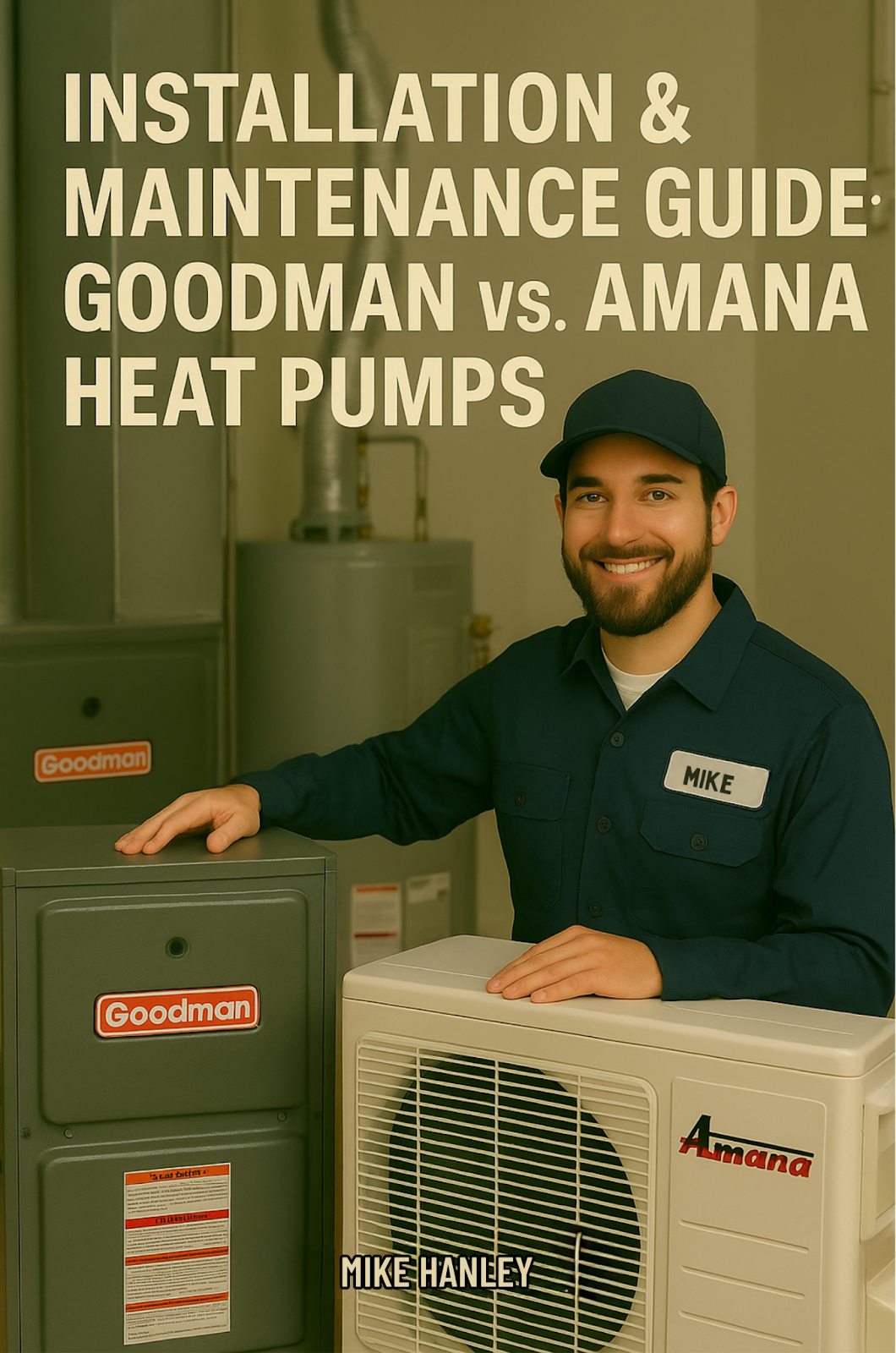📘 Table of Contents
🏠 What This Guide Covers
Proper installation and maintenance make the difference between a heat pump that runs efficiently for decades and one that fails prematurely. Goodman central heat pump systems and Amana PTAC units have different installation requirements, but both need regular care to maintain efficiency, safety, and warranty coverage.
In this article I will walk you through installation needs for each system and explain maintenance tasks you can handle yourself and those requiring a pro. I will also highlight associated costs so you can plan intelligently.
🔧 Installation Requirements & Considerations
Professional installation affects system efficiency and longevity, so here is what to know:
-
Ductwork or Sleeves
Goodman units need compatible ductwork and air handlers. Amana PTAC units go into a wall sleeve, no ducts required. -
Electrical & Refrigerant Setup
Both systems require licensed technicians to wire the power and charge refrigerant to manufacturer specifications. The Department of Energy warns after-installation setup errors can reduce up to 30% of system efficiency. -
Permits & Compliance
Most places require HVAC installation permits. Compliance with local building codes protects your warranty and home. -
Site Preparedness
Ensure a clear installation area and space for outdoor units. Goodman systems require stable, level pad space and clearance for airflow; Amana PTAC requires a level sleeve opening and proper sealing against weather.
⏳ Ongoing Maintenance: What to Expect
Regular servicing keeps both systems operating efficiently and safely:
-
Goodman Heat Pumps
Expect annual professional tune-ups. Your contractor should inspect refrigerant levels, clean coils, lubricate motors, test safety systems, and calibrate thermostats. The Building Performance Institute recommends scheduling maintenance before each heating and cooling season for optimal performance. -
Amana PTAC Units
PTAC maintenance includes filter cleaning/replacement every 1–3 months and seasonal service checks. Inspect drain lines, check thermostats, and replace filters regularly to maintain air quality.
The Air Conditioning Contractors of America (ACCA) recommends HVAC systems be inspected at least once a year to preserve efficiency and performance.
💡 DIY vs. Pro Maintenance
Here’s what you can do on your own and what needs a certified technician:
|
Task |
DIY? |
Why |
|
Filter replacement |
Yes |
Simple, safe, improves airflow |
|
Condenser cleaning |
Yes |
Gently rinse with hose |
|
Thermostat check |
Yes |
Replace batteries yourself |
|
Coil cleaning (deep) |
No |
Need to open systems |
|
Refrigerant recharge |
No |
Requires EPA-certified tools |
|
Electrical component check |
No |
Risk of shock or damage |
|
Safety system inspection |
No |
Professionals detect leaks |
DIY work keeps us proactive and budget-conscious. It is best paired with professional yearly maintenance for safety and warranty protection.
💵 Typical Costs & Budgeting Tips
Here is an estimated cost breakdown:
-
Goodman Installation
-
Heat pump unit: $3,500 - $4,500
-
Installer labor: $1,500 - $2,500
-
Ductwork or air handler add-ons: $1,000+ if needed
-
Amana PTAC Installation
-
PTAC unit: ~$800
-
Wall sleeve and necessary accessories: $200 – $500
-
Installation labor: $500 - $800
-
Annual Maintenance Costs
-
Central system tune-up: $100 - $300
-
PTAC seasonal check: $75 - $150
Consider these money-saving options: permits typically cost $50-$200, utility rebates can save $100-$500, and bundled service contracts often reduce per-visit costs by 15-20%. Efficiency rebates may reduce Goodman's overall expense thanks to ENERGY STAR qualification.
🏁 Key Takeaways and Action Plan
Proper installation and consistent maintenance are the foundation of reliable, efficient heat pump performance. Whether it is a Goodman system or an Amana PTAC, trust in professional service for setup and safety checks; handle routine tasks like filter changes yourself to keep things running smoothly.
This wraps up our series. If you need help choosing or installing the right heat pump, feel free to reach out.
-
🔙 Return to Pillar: Goodman vs. Amana Heat Pump Brand Showdown
-
🔙 Previous Article: Amana PTAC Heat Pumps: Pros, Cons & Ideal Uses
-
🛠 Need equipment?
-
🌐 Explore more: Heat Pump Systems Collection
❓ FAQ
Q: Can I install a Goodman heat pump myself?
A: No. Installation involves refrigerant handling, electrical work, and calibrating airflow. Hiring a licensed HVAC technician is required.
Q: Will a PTAC unit meet central heat needs?
A: A single PTAC unit is intended for one room. For whole-home heating, use multiple units or choose a central system like Goodman.
Q: How often should I schedule tune-ups?
A: Central systems should be serviced annually. PTAC units also benefit from annual checks even if filters are replaced more often.
Q: Can DIY maintenance void my warranty?
A: No, as long as you keep records, register the unit, and maintain annual professional service. Skip annual checks and you risk invalidating your warranty.
Q: Are there permits required for installation?
A: Almost always. HVAC systems use electricity, refrigerant, and alter airflow patterns; permits ensure safety and local compliance.







